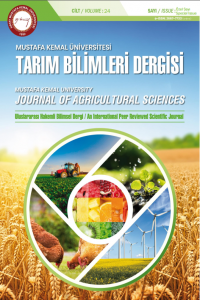Estimation of monthly precipitation based on machine learning methods by using meteorological variables
Abstract
Aims: The aim of this study is to estimate monthly precipitation by support vector regression and the nearest neighbourhood methods using meteorological variables data of Chabahar station.
Methods and Results: monthly precipitation was modelled by using two support vector regression and the nearest neighbourhood methods based on the two proposed input combinations.
Conclusions: The results showed that the support vector regression method using normalized polynomial kernel function has higher accuracy and it has lower estimation error than the nearest neighbour method.
Significance and Impact of the Study: Precipitation is one of the most important parts of the water cycle and plays an important role in assessing the climatic characteristics of each region. Modelling of monthly precipitation values for a variety of purposes, such as flood and sediment control, runoff, sediment, irrigation planning, and river basin management, is very important. The modelling of precipitation in each region requires the existence of accurately measured historical data such as humidity, temperature, wind speed, etc. Limitations such as insufficient knowledge of precipitation on spatial and temporal scales as well as the complexity of the relationship between precipitation-related climatic parameters make it impossible to estimate precipitation using conventional inaccurate and unreliable methods
References
- Asghari K and Nasseri M (2014). Spatial rainfall prediction using optimal features selection approaches. Hydrology Research, 46(3), 343-355.
- Bostan P A, Heuvelink G B, & Akyurek S Z. (2012). Comparison of regression and kriging techniques for mapping the average annual precipitation of Turkey. International Journal of Applied Earth Observation and Geoinformation, 19, 115-126.
- Breiman L (2001) Random Forests. Machine Learning 45(1): pp. 5–32.
- Bushara N O, 2016. Rainfall forecasting in sudan using computational inteligence, A Dissertation submitting to Ph.D. degree.
- Eyvazi M, Mosaedi A (2012) Investigation of spatial expansion pattern of rainfall in Golestan province using definite models and statistical pitch. Water and soil Journal, 26 (1). (Article is in Persian with English Abstract).
- Hall M A (1999). Correlation-based feature selection for machine learning.
- Ji S Y, Sharma S, Yu B, & Jeong D H (2012, August). Designing a rule-based hourly rainfall prediction model. In 2012 IEEE 13th International Conference on Information Reuse & Integration (IRI) (pp. 303-308). IEEE.
- Khandelwal N, & Davey R (2012). Climatic Assessment Of Rajasthan’s Region For Drought With Concern Of Data Mining Techniques. Concern, 2(5).
- Olaiya F, & Adeyemo A B (2012). Application of data mining techniques in weather prediction and climate change studies. International Journal of Information Engineering and Electronic Business, 4(1), 51.
- Sethi N, & Garg K (2014). Exploiting data mining technique for rainfall prediction. International Journal of Computer Science and Information Technologies, 5(3), 3982-3984. Sharif M H, and Burn D (2006). “Simulating climate change scenarios using an improved K-nearest neighbor model.” J. of Hydrology, 325, 179-196.
- Sivaramakrishnan T R, & Meganathan S (2012). Point rainfall prediction using data mining technique. Research Journal of Applied Sciences, Engineering and Technology, 4(13), 1899-1902.
- URL1:https://datamarket.com/data/set/13dz/average-precipitation-in-depth-mm-per-year#!ds=13dz!ff5=f.5.1d.4l.1k.2c.23.2t.18.2y.30.4j.1u.6.3o.15.2b.2v.24.3i.4u.1r.3l.4v.4p.2f.x.r.2g.y.4y.48.14.21.1h.2e.3t.3e.2p.2z.26.1g.4f.1p.p.3u.3z.c.4o.1z.g.4n.45.1a.t.3m.l.1.3j.q.3b.2.4h.35.27.1x.1q.i.2k.1l.3v.1j.2q.4t.2x.7.3h.37.33.39.3y.11.1c.1v.31.3c.4s.1s.3d.29.d.17.3s.28.22.z.43.v.3f.54.1t.44.w.2l.41.3p.4q.1y.2n.46.1m.4k.3w.4m.4w.2a.36.2s.10.4x.1n.3k.38.4c.19.1b.1e.5c.4.16.a.4i.2o.1f.5b.20.3r.25.n.4g.3q.s.j.3.8.2m.4z.42.h.49.4r.4a.e.2w.3n.40.2j.b.13.53.2h.4d.3g.34.2i.50&display=choropleth&map=world&classifier=natural&numclasses=5/.
- URL2: https://www.chaharmahalmet.ir/.
- Wang Z L, & Sheng H H (2010, December). Rainfall prediction using generalized regression neural network: case study Zhengzhou. In 2010 International conference on computational and information sciences (pp. 1265-1268). IEEE.
- Zaw W T, & Naing T T (2008). Empirical statistical modeling of rainfall prediction over Myanmar. World Academy of Science, Engineering and Technology, 2(10), 500-504.
Abstract
References
- Asghari K and Nasseri M (2014). Spatial rainfall prediction using optimal features selection approaches. Hydrology Research, 46(3), 343-355.
- Bostan P A, Heuvelink G B, & Akyurek S Z. (2012). Comparison of regression and kriging techniques for mapping the average annual precipitation of Turkey. International Journal of Applied Earth Observation and Geoinformation, 19, 115-126.
- Breiman L (2001) Random Forests. Machine Learning 45(1): pp. 5–32.
- Bushara N O, 2016. Rainfall forecasting in sudan using computational inteligence, A Dissertation submitting to Ph.D. degree.
- Eyvazi M, Mosaedi A (2012) Investigation of spatial expansion pattern of rainfall in Golestan province using definite models and statistical pitch. Water and soil Journal, 26 (1). (Article is in Persian with English Abstract).
- Hall M A (1999). Correlation-based feature selection for machine learning.
- Ji S Y, Sharma S, Yu B, & Jeong D H (2012, August). Designing a rule-based hourly rainfall prediction model. In 2012 IEEE 13th International Conference on Information Reuse & Integration (IRI) (pp. 303-308). IEEE.
- Khandelwal N, & Davey R (2012). Climatic Assessment Of Rajasthan’s Region For Drought With Concern Of Data Mining Techniques. Concern, 2(5).
- Olaiya F, & Adeyemo A B (2012). Application of data mining techniques in weather prediction and climate change studies. International Journal of Information Engineering and Electronic Business, 4(1), 51.
- Sethi N, & Garg K (2014). Exploiting data mining technique for rainfall prediction. International Journal of Computer Science and Information Technologies, 5(3), 3982-3984. Sharif M H, and Burn D (2006). “Simulating climate change scenarios using an improved K-nearest neighbor model.” J. of Hydrology, 325, 179-196.
- Sivaramakrishnan T R, & Meganathan S (2012). Point rainfall prediction using data mining technique. Research Journal of Applied Sciences, Engineering and Technology, 4(13), 1899-1902.
- URL1:https://datamarket.com/data/set/13dz/average-precipitation-in-depth-mm-per-year#!ds=13dz!ff5=f.5.1d.4l.1k.2c.23.2t.18.2y.30.4j.1u.6.3o.15.2b.2v.24.3i.4u.1r.3l.4v.4p.2f.x.r.2g.y.4y.48.14.21.1h.2e.3t.3e.2p.2z.26.1g.4f.1p.p.3u.3z.c.4o.1z.g.4n.45.1a.t.3m.l.1.3j.q.3b.2.4h.35.27.1x.1q.i.2k.1l.3v.1j.2q.4t.2x.7.3h.37.33.39.3y.11.1c.1v.31.3c.4s.1s.3d.29.d.17.3s.28.22.z.43.v.3f.54.1t.44.w.2l.41.3p.4q.1y.2n.46.1m.4k.3w.4m.4w.2a.36.2s.10.4x.1n.3k.38.4c.19.1b.1e.5c.4.16.a.4i.2o.1f.5b.20.3r.25.n.4g.3q.s.j.3.8.2m.4z.42.h.49.4r.4a.e.2w.3n.40.2j.b.13.53.2h.4d.3g.34.2i.50&display=choropleth&map=world&classifier=natural&numclasses=5/.
- URL2: https://www.chaharmahalmet.ir/.
- Wang Z L, & Sheng H H (2010, December). Rainfall prediction using generalized regression neural network: case study Zhengzhou. In 2010 International conference on computational and information sciences (pp. 1265-1268). IEEE.
- Zaw W T, & Naing T T (2008). Empirical statistical modeling of rainfall prediction over Myanmar. World Academy of Science, Engineering and Technology, 2(10), 500-504.
Details
| Primary Language | English |
|---|---|
| Subjects | Environmental Sciences, Agricultural Engineering |
| Journal Section | Araştırma Makalesi |
| Authors | |
| Publication Date | December 27, 2019 |
| Submission Date | November 27, 2019 |
| Acceptance Date | December 17, 2019 |
| Published in Issue | Year 2019 Special Issue: 1st Int. Congress on Biosystems Engineering 2019 |

